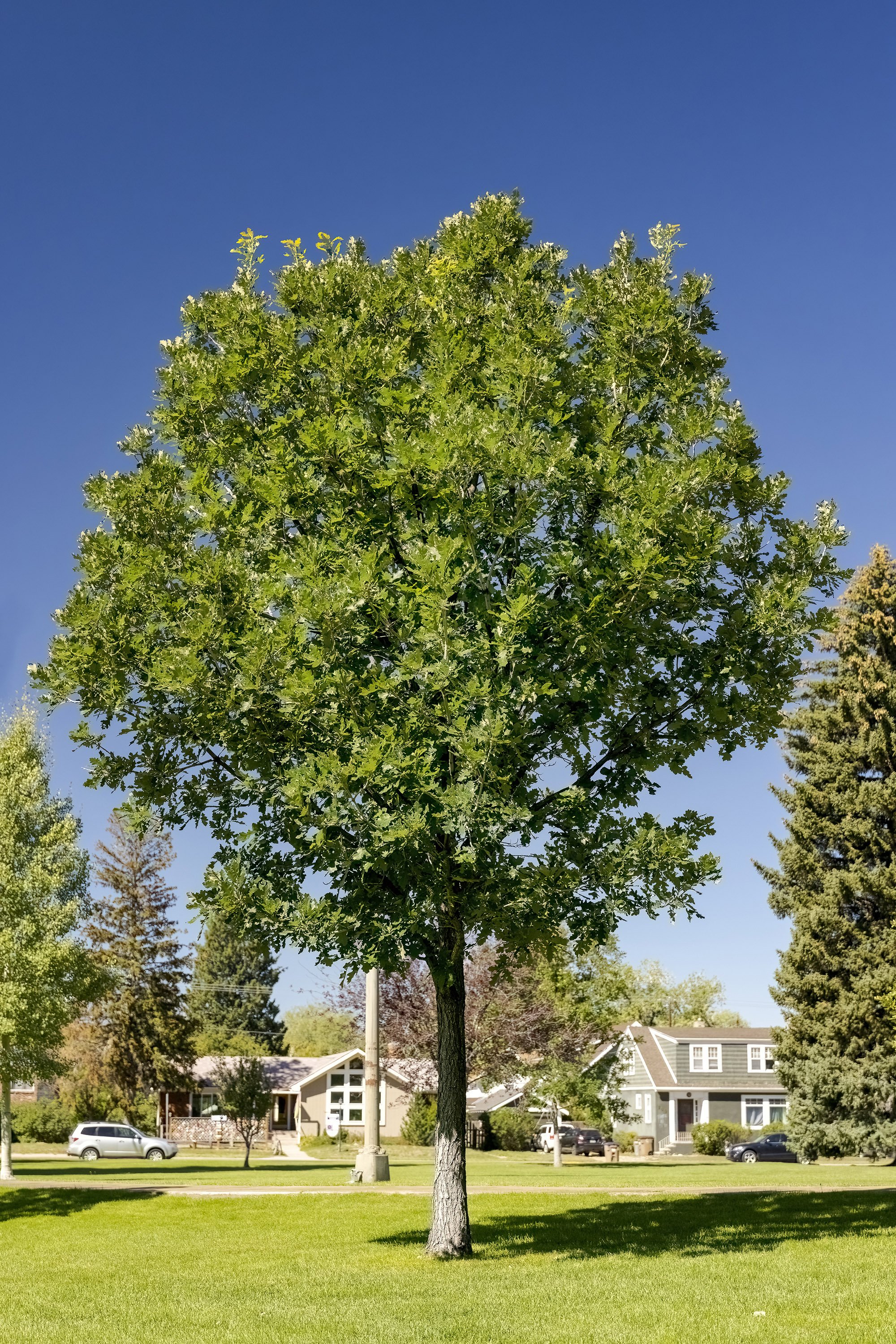 Image 1 of 6
Image 1 of 6

 Image 2 of 6
Image 2 of 6

 Image 3 of 6
Image 3 of 6

 Image 4 of 6
Image 4 of 6

 Image 5 of 6
Image 5 of 6

 Image 6 of 6
Image 6 of 6







Bur Oak
Quercus macrocarpa
Hardiness Zone: 3
Height: 60-80 feet
Spread: 80 feet
Sun: full sun, part shade
Maintenance: low
Drought Tolerance: fairly drought tolerant, once established
Growth Rate: slow
Soil Composition: variety of soils, prefers well-drained
Description: The classic native North American shade tree is a slow grower but can last for 200 years. Known for its open, wide-spreading crown and large acorns that are beneficial to wildlife. Mature bark is dark gray to brown with deep furrows. Stems are stout and smooth but young twigs can develop corky ridges. Tolerant of a variety of moisture and soil conditions, which allows it to adapt well to urban settings. Bur oaks grow well in acidic, alkaline, loamy, sandy, well-drained, wet and clay soils.
Attributes: This tree offers dense shade thanks to its rounded shape, can tolerate pollution and heat stress, large ornamental leaves and while it prefers moderate moisture, the tree has some drought tolerance.
Wildlife Value: Bur oak acorns are the preferred food for wood ducks, wild turkeys, white-tailed deer, rabbits, mice, squirrels and other rodents.
Planting & Growing: Bur oaks can be difficult to transplant under more stressful conditions. Prune oaks in the dormant season to avoid attracting beetles that may carry oak wilt. Oaks do not like compacted soils or having their roots disturbed, so protect the root zone.
Best grown in front/back yards, and in the landscape parking strip, at least 8 feet wide, along city streets. Plant 10 feet from fire hydrants, ground-mounted utility boxes, fences, shrubs, private sidewalks and driveways. Plant at least 20 feet from buildings. Plant at least 30 feet from all other trees. Plant at least 60 feet from overhead powerlines.
Source: National Arbor Day Foundation (arborday.org)
Quercus macrocarpa
Hardiness Zone: 3
Height: 60-80 feet
Spread: 80 feet
Sun: full sun, part shade
Maintenance: low
Drought Tolerance: fairly drought tolerant, once established
Growth Rate: slow
Soil Composition: variety of soils, prefers well-drained
Description: The classic native North American shade tree is a slow grower but can last for 200 years. Known for its open, wide-spreading crown and large acorns that are beneficial to wildlife. Mature bark is dark gray to brown with deep furrows. Stems are stout and smooth but young twigs can develop corky ridges. Tolerant of a variety of moisture and soil conditions, which allows it to adapt well to urban settings. Bur oaks grow well in acidic, alkaline, loamy, sandy, well-drained, wet and clay soils.
Attributes: This tree offers dense shade thanks to its rounded shape, can tolerate pollution and heat stress, large ornamental leaves and while it prefers moderate moisture, the tree has some drought tolerance.
Wildlife Value: Bur oak acorns are the preferred food for wood ducks, wild turkeys, white-tailed deer, rabbits, mice, squirrels and other rodents.
Planting & Growing: Bur oaks can be difficult to transplant under more stressful conditions. Prune oaks in the dormant season to avoid attracting beetles that may carry oak wilt. Oaks do not like compacted soils or having their roots disturbed, so protect the root zone.
Best grown in front/back yards, and in the landscape parking strip, at least 8 feet wide, along city streets. Plant 10 feet from fire hydrants, ground-mounted utility boxes, fences, shrubs, private sidewalks and driveways. Plant at least 20 feet from buildings. Plant at least 30 feet from all other trees. Plant at least 60 feet from overhead powerlines.
Source: National Arbor Day Foundation (arborday.org)
Quercus macrocarpa
Hardiness Zone: 3
Height: 60-80 feet
Spread: 80 feet
Sun: full sun, part shade
Maintenance: low
Drought Tolerance: fairly drought tolerant, once established
Growth Rate: slow
Soil Composition: variety of soils, prefers well-drained
Description: The classic native North American shade tree is a slow grower but can last for 200 years. Known for its open, wide-spreading crown and large acorns that are beneficial to wildlife. Mature bark is dark gray to brown with deep furrows. Stems are stout and smooth but young twigs can develop corky ridges. Tolerant of a variety of moisture and soil conditions, which allows it to adapt well to urban settings. Bur oaks grow well in acidic, alkaline, loamy, sandy, well-drained, wet and clay soils.
Attributes: This tree offers dense shade thanks to its rounded shape, can tolerate pollution and heat stress, large ornamental leaves and while it prefers moderate moisture, the tree has some drought tolerance.
Wildlife Value: Bur oak acorns are the preferred food for wood ducks, wild turkeys, white-tailed deer, rabbits, mice, squirrels and other rodents.
Planting & Growing: Bur oaks can be difficult to transplant under more stressful conditions. Prune oaks in the dormant season to avoid attracting beetles that may carry oak wilt. Oaks do not like compacted soils or having their roots disturbed, so protect the root zone.
Best grown in front/back yards, and in the landscape parking strip, at least 8 feet wide, along city streets. Plant 10 feet from fire hydrants, ground-mounted utility boxes, fences, shrubs, private sidewalks and driveways. Plant at least 20 feet from buildings. Plant at least 30 feet from all other trees. Plant at least 60 feet from overhead powerlines.
Source: National Arbor Day Foundation (arborday.org)